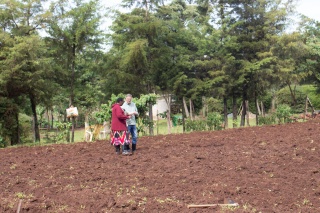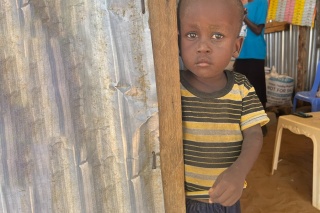
How Do We Stop The Global Hunger Crisis?
"Hunger is not caused by a lack of food, but by swathes of humanity being unable to buy that which is available."
After a visit to Kenya in Mary’s Meals’ 20th year, the founder lays bare the extreme hardships facing children in this increasingly unliveable environment, and makes plain the simple and achievable objective to eliminating child hunger in this world of plenty.
I am squelching through the wet black mud of a field, in Nandi County, Kenya, a fistful of beans in my hand, while Josephine explains to me the current challenges, she and her hoe wielding co-workers face.
‘Someone just needs to explain to us how a war in Ukraine is making our fertiliser more expensive. Really, it makes no sense to me,’ she says indignantly before starting to drop the beans into another freshly dug furrow.
Josephine, and her friends, who in 2009 founded Cheptarit Star Women’s Group in Nandi County, were impoverished farmers who pooled their meagre resources, and bought maize from their new collective to sell at better prices. They surprised themselves in the years since by growing into a larger enterprise than they had ever planned and along the way developed an impressive track record in overcoming the odds stacked against them. Those odds, though, are being stacked higher than ever today.
Across the world, farmers like Josephine are using less fertiliser on their crops because they simply cannot afford to purchase the usual quantities. The impact of this – in the form of smaller than usual harvests - will only be felt many months down the line. But even today hunger is stalking this land.
Famines do not appear overnight. They are many months - or more likely years – in the making, and even then, they only threaten the lives of the poor, the marginalised and the disenfranchised.
A few hours north of that field of beans, the arid lands of Turkana are drier than ever, this being the fourth consecutive year of drought here. At dawn I walk through the dust with Ekai, his son Elar and their herd of goats towards the Kerio River. It, at least, is full with water that has fallen many miles from here. On the way we pass Ekai’s unplanted fields. Not a drop of rain has fallen on them for two years now and there is no point in him planting anything in the parched cracked earth.
Ekai tells me that some people’s animals here are beginning to die and that soon people will too. He believes some in is his own community and even his own family will not make it. He looks up at the sky and then down at his son and says that in the next few days they will pack up their few belongings and move in search of grazing for their animals. That has long been the way of it for the semi-nomadic pastoralists of Turkana, who are no strangers to adversity and having to move and continuously adapt to changing circumstances. But this is a truly desperate situation. Today in Turkana it is estimated that 50% of the children are acutely malnourished. And across the Horn of Africa 15 million people are experiencing acute hunger and starvation. According to a recent estimate by Save the Children and Oxfam one person is dying of hunger every 48 seconds in this region and that by the summer 350,000 people will have perished – unless an urgent intervention takes place.
Meanwhile, globally, the number of hungry people has doubled in two years, while those living in outright famine have increased 500% since 2016. The bold aspiration proclaimed by the international community in 2015, when it stated ‘Zero Hunger by 2030’ as its second Sustainable Development Goal, might be thought of as an absurd, out of date and out of reach, objective. One best forgotten about for now. But perhaps the opposite is true.
There is today a great risk that unforeseen cataclysmic events – the Covid pandemic and the war in Ukraine - give us new reasons to accept chronic hunger and famine as a terrible but unavoidable reality beyond our control. But that would be a lie – one perpetuated long before these global shocks occurred. For even now there is still enough food in the world for all of humanity. And there is the potential to produce a whole lot more. And while the blame for some things, such as the pandemic, cannot be laid squarely at the feet of humanity, the other key drivers such as climate change, conflict, poverty and inequality certainly can be. Indeed, it might not be an exaggeration to say famines are always man-made – at very least it is true to say they could always be avoided if there was the will by humanity at large to take certain actions.
Famines do not appear overnight. They are many months - or more likely years – in the making, and even then, they only threaten the lives of the poor, the marginalised and the disenfranchised. People with money do not die in famines, because hunger is not caused by a lack of food, but by swathes of humanity being unable to buy that which is available. Of course, this is accentuated when pressures on supply and distribution (including conflict and the deliberate use of hunger as a weapon of war such as in Tigray today) occur. And so any meaningful attempt at achieving Zero Hunger needs to involve peace building – and especially the eradication of extreme poverty (it is no co-incidence that the first Sustainable Development Goal is No Poverty by 2030).
But where to begin amidst all of this overwhelming bad news? Perhaps in a nursery school in a small tin hut in Turkana where a queue of children are being served their daily school meal by local volunteers. Mary’s Meals sets up school feeding programmes like this across the world’s poorest communities, where hunger is preventing millions of children gaining an education – many of them like my young goat herding friend Elar, are working to help their family survive rather than receiving an education that is absolutely key to breaking this cycle of poverty and malnutrition. In lives like his, we see that hunger is not just a result of poverty, but the cause of it too – in this generation and the next. And, in the children queuing for their maize and beans and their energetic learning of the alphabet afterwards, we see that this cycle of poverty can indeed be broken by this simple serving of a daily meal.
Today Mary’s Meals is providing 120,000 children each day in Turkana with a meal in their place of education and serving 2.2 million children in this way across 20 of the world’s poorest countries. A bit like the ladies of Cheparit Star in Nandi County Mary’s Meals started small – feeding 200 children in a school in Malawi in 2002. In the 20 years since the work has grown exponentially simply because it works. Without that being the case local volunteers in thousands of impoverished communities in countries such as South Sudan, Haiti and Madagascar would not be putting up their hands and saying, ‘I’m in’.
These are not people who volunteer because they are bored, faced as they are with a relentless daily struggle to stay alive. They give up their time freely in their local schools and nurseries because they can see that serving the meals is saving the lives of their children and, at the same time, tackling the longer-term problems by enabling their education. And they volunteer because hunger, for them, is not some abstract concept, described by the frightening statistics like those I quoted above. It is personal. It is the ache in their own stomach. It is the distended belly of their neighbour’s child. It is the terror of not being able to feed their own child tomorrow. It is the daylight robbery of their children’s hopes and dreams. And so, they take up arms anyway they can.
And one other thing I notice in that little nursery. The big sacks of food beside the cooking pot, are the same ones filled by the Cheptarit Star Women’s Group, whose beans and maize grown a few hours south of here, are the food these children eat each day. The success of that co-operative has been made possible by the guaranteed market created by the Mary’s Meals programme, which is not only meeting the immediate need of the hungry child and making possible their education, but also enabling small holder farmers to grow more food, assured of fair prices year-round. And surely the benefits of increased local food production and shorter supply chains are more glaringly obvious than they have ever been?
And so, if we are at all serious about the achievement of Zero Hunger, why would we not start with a commitment to ensuring that every child in this world receives a daily meal in their place of education. This is the vision of Mary’s Meals, dearly held by a growing band of volunteers and supporters across the world. And it is a relatively low cost intervention - one that can indeed be realised. It is one that would represent a huge stride towards a world in which ‘Zero Hunger’ could be achieved and sustained.
We can use the current global disruption as a new excuse to delay making such a promise to the world’s children, or we can hear their cry and decide that there is no better time than now, to end this intolerable negligence of ours.
Food changes the story
Together we can make a difference



